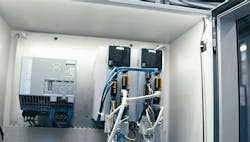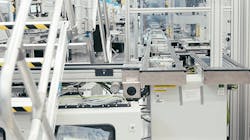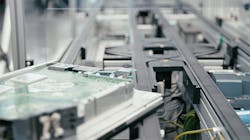Craig Nelson is product marketing manager, Sinamics S-series drives at Siemens Industry.
What have been the biggest improvements to motor and drives in the past five years?
Craig Nelson, product marketing manager, Sinamics, Siemens Industry: The range of drive-based safety-integrated functions available in the past years has led to some revolutionary safety concepts to mitigate safety risk while increasing production. These extended drive-based safety functions utilize safety-rated encoders and, in many cases, a safe communications telegram to a safety-rated PLC to protect the operators with safety-rated functions such as safe speed, safe torque, safe direction and safe limited position. New to the scene are the integrated testing, verification and documentation of the safety functionality into the solution for drive-based safety-integrated technology. This has led to increased protection levels from manipulation or harmful changes over the complete lifecycle of the system. Future machine innovations and software design tools including simulation and virtual commissioning are utilizing these innovative safety concepts to form the framework of the latest production environments with higher levels of efficiency and safer operation (Figure 1). New production environments with increased robotics and mobile equipment such as automated guided vehicles (AGVs) have readily implemented the newest safety-integrated technology due to the limitations of conventional safety concepts on these applications.
What’s the most innovative or efficient motor/drive application you’ve ever seen or been involved with?
Craig Nelson, product marketing manager, Sinamics, Siemens Industry: The growing need for test stands in the electric-vehicle (EV) market and the nature of greener solutions have led to the adoption of a complete highly efficient electrical test system. Using high-efficient motors to recapture the power in the drive system, between the drive end and load end, allows for minimal power usage in what could be a very high-power demanding application. The key to limiting the total power usage is being able to recover the regenerative power of one axis to feed the motoring power of the other axis. We see an expansion of electrical drive applications utilizing a connected dc bus in many other green-related applications including battery charging and power storage.
Figure 2: Utilizing standard libraries for drive control has also reduced engineering time and complexity allowing the novice PLC programmer to now become drive-savvy with limited training.
How have motors and drives benefitted from remote monitoring and connectivity?
Craig Nelson, product marketing manager, Sinamics, Siemens Industry: Monitoring drives and motors is typically key to understanding the state of a machine, and this data often is analyzed to notify someone in case of anomalies or faults. Machine builders, or original equipment manufacturers (OEMs), and end customers are now realizing the benefits of this reduced downtime and adapting to the changes COVID has brought us by utilizing remote monitoring. For OEMs that are being relied upon for increased fleet service and maintenance by their customers, while facing resource issues and travel limitations, being able to securely connect remotely is now at the forefront of every requirement for drive systems. In the future, as we increase the data analytics of drive and motor operation and use such simulation tools as hardware and software in the loop for optimizing the development and engineering of new machine iterations, being able to utilize the connectivity to gather operational information will gain importance.
Can you explain how software development has changed motor and drive design and production?
Craig Nelson, product marketing manager, Sinamics, Siemens Industry: Software development in the complete lifecycle of drive systems is increasing in visibility. The digital twin of machines is being improved with the physical simulation model of the drive train and applied from the virtual design in the beginning through engineering and commissioning and then closes the loop back with data analytics for ongoing improvements and future design iterations. In many cases, drive trains are oversized, which leads to increased size and cost, as well as a less efficient system; and, by use of data analytics, this can be optimized instead of repeated. Software development is not only allowing us to replace hardware with software, as can be readily seen in motion control with the elimination of gears and cams, but complete system replacement that can be seen in the hydraulics-to-servo migration.
How do motors and drives figure into digital-twin platform models being used by manufacturers?
Craig Nelson, product marketing manager, Sinamics, Siemens Industry: Physical simulation models of the drive train are being used in simulation software to build up a parallel virtual world and optimize the complete lifecycle. The digital twin of machines is being improved with physical simulation models of the drive train called functional mockup unit (FMU). The FMU can be applied in the virtual design in the beginning for proof of concept and then through virtual commissioning. Optimizing the design and data analytics for ongoing improvements and future design iterations offer valuable competitive advantages.
Figure 3: Smaller footprints with lower power losses result in smaller electrical cabinets with fewer cooling requirements.
When will motors and drives become IT-friendly enough that engineers are no longer required for installation and operation?
Craig Nelson, product marketing manager, Sinamics, Siemens Industry: In the first month of my electrical-drive career, the first digital drive showed up, and the salesman looked at me and said, “We aren’t going to need you drive guys anymore.” I went home that night and started looking for a different career. That was more than 30 years ago. What we are seeing, however, are new smarter devices with drives and motors that reduce setup and integration time with plug-and-play configuration. Utilizing standard libraries for drive control has also reduced engineering time and complexity allowing the novice PLC programmer to now become drive-savvy with limited training, which is typically done with videos (Figure 2).
Figure 4: The developments around time-sensitive networking (TSN) are promising and greatly help with the ongoing battle of limitations vs. complexity for highly coordinated drive systems.
What future innovations will impact the use of motors and drives in discrete-manufacturing operations?
Craig Nelson, product marketing manager, Sinamics, Siemens Industry: The next-generation power devices offer many advantages over the silicon devices in use. This will lead to smaller footprints with lower power losses resulting in smaller electrical cabinets with fewer cooling requirements (Figure 3). Communication demands between devices, along with edge and cloud connectivity, will lead to more built-in and uniformed communications such as OPC UA. In motion-control applications, the developments around time-sensitive networking (TSN) are promising and greatly help with the ongoing battle of limitations vs. complexity for highly coordinated drive systems (Figure 4).
Tell us about your company’s state-of-the-art motor or drive.
Craig Nelson, product marketing manager, Sinamics, Siemens Industry: The Siemens Sinamics S210 servo package is a high-performance solution that has been specifically designed for ease of implementation. From its straightforward selection of a servo package with 100 W to 7 kW ratings to its ease of drag-and-drop engineering inside the TIA Portal to its one-cable connection from drive to motor for easy installation, the Sinamics S210 package reduces engineering time and effort dramatically. Additionally, the easy linking of the three-phase ac connection and dc bus for power sharing provides an efficient solution for mid-range machines from two to six axes. Initially, the offering for the Sinamics S210 servo system included the Simotics S-1FK2 synchronous servo motor. The 1FK2 motors were used as a base offering to expand motor features with the 1FT2 motors regarding higher-rated speed, higher-resolution encoder, higher environmental protection and even different colors. With the recent addition of the 1FS2 stainless steel servomotor, this servo package has greatly expanded its application range in the food-and-beverage and pharmaceutical industries, which require these motor characteristics for very high hygiene and cleanliness requirements.
Mike Bacidore is the editor in chief for Control Design magazine. He is an award-winning columnist, earning a Gold Regional Award and a Silver National Award from the American Society of Business Publication Editors. Email him at [email protected].
About the Author
Mike Bacidore
Editor in Chief
Mike Bacidore is chief editor of Control Design and has been an integral part of the Endeavor Business Media editorial team since 2007. Previously, he was editorial director at Hughes Communications and a portfolio manager of the human resources and labor law areas at Wolters Kluwer. Bacidore holds a BA from the University of Illinois and an MBA from Lake Forest Graduate School of Management. He is an award-winning columnist, earning multiple regional and national awards from the American Society of Business Publication Editors. He may be reached at [email protected]

Leaders relevant to this article:





